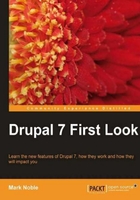
Like any major development project, there are always a few things that you would like to implement but couldn't complete for various reasons. For Drupal 7, there were two initial goals that were not completed.
Initially, putting a WYSIWYG editor into Drupal was desired to help content editors to edit their sites more easily. However, this effort was postponed from Drupal 7 due to the lack of a standard WYSIWYG editor that could be included and the need for more design to create a solution that will work for a majority of users. Although there is not a full-fledged WYSIWYG editor in core, a number of changes have been made to core to help future integration efforts. We will review these changes more in Chapters 2 and 3. Much of the work that was done for Drupal 7 is now available in the contributed WYSIWYG module (http://drupal.org/project/wysiwyg). We will review the WYSIWYG module in more detail in Chapter 4.
The other main goal that was not realized was the inclusion of Views within Drupal core. This is primarily due to the complexity of Views and determination of whether or not the entire functionality of Views should be included in Drupal 7 or if only a subset of the functionality belonged within Drupal 7. However, several concepts that originated from the Views interface have migrated into Drupal core and the new DBTNG API makes it easier for developers to create complex queries of the Drupal database.